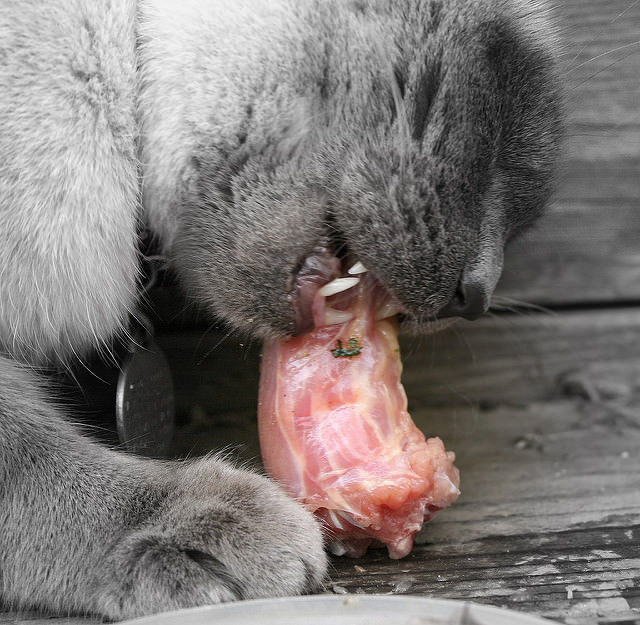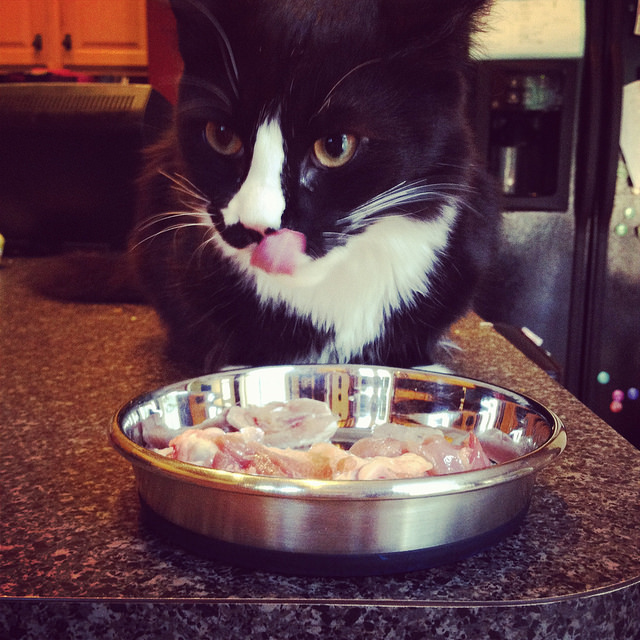With interest in feline health and nutrition higher than it’s ever been, more and more cat owners are switching their pets to a raw diet. The benefits are well worth the time and effort, even if it might seem scary at first. While there are many people out there that disagree with raw diets, we want to encourage you to get all the facts before falling for the scare tactics. If you’re reading this, you probably already know that commercial pet foods can contain some very unfavorable ingredients. Learning more about raw diets and how to properly make them will open up a new door of health and wellness for your cat.
#1 – Bones
For decades people have been told not to feed their cats bones, especially chicken bones. While cooked bones are very dangerous and should be avoided, raw bones are actually quite soft. This makes them easy for your cat to break up and chew and they don’t splinter like cooked bones do. Raw bones are very safe for cats to ingest. When feeding a raw diet, you’re going to want to focus on raw meaty bones – that is, bones that your cat can break up and chew (think chicken wings, chicken necks, etc). This is opposed to recreational bones, such as beef knuckles, that can’t be digested in a single meal. The type of bones your cat can chew in a sitting will depend on your cat’s size, age and health.

#2 – Balance Over Time
Many people are focused on creating the optimum meal every single time their cat eats. Commercial foods have long since advertised fully balanced meals, but when feeding a raw diet the goal is to balance nutrition over time. Think about the way you eat – do you eat a fully balanced meal with proper nutrients every single time you eat? Probably not. Instead, you focus on getting your nutritional needs across your diet as a whole. Supplements can be added if you think they’re needed, but many raw feeders don’t use any.
#3 – Food-Borne Illness
One of the biggest scare tactics against raw diets is food-borne illnesses. Yes, there is a chance that handling raw meat will pose a risk to you, but using basic food safety you should not have to worry about food-borne pathogens. Further, cats have evolved to have very strong guts. This means they’re capable of digesting salmonella and other pathogens without getting sick at all. Think about animals in the wild – they are eating rotten meat quite often and don’t skip a beat!
#4 – All the Foods
The fun part about raw feeding is that you can feed pretty much anything your cat likes. You’ll want to feed raw meaty bones, muscle meat and organ meat. Some people include fruit and vegetables, but not everyone does. The more variety your cat has, assuming they can handle it without any allergies or other ill effects, the better. Consider varying protein between sources available to you such as chicken, turkey, beef, pork, duck and fish. If there’s something your cat really enjoys, feed it to them!

#5 – The Right Amount
How much you feed depends on a number of different factors. For adult cats, the general rule is 2-3% of your cat’s body weight (or targeted body weight if your cat is over- or underweight). Kittens and pregnant and lactating females will need more, seniors will likely need less. Without any math, though, you’ll just want to feed the amount of food that keeps your cat at a healthy weight!
As with any new diet, there is a learning curve when switching to raw. However, the benefits greatly outweigh the risks and your kitty is likely not to experience more than an upset stomach from time to time. Once you’ve got everything worked out, you’re both going to experience a whole newfound love for cat food.
